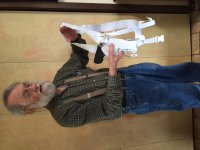Different guns, different alloys, different size cylinders, different amounts of force in "the flip" I don't see where you could say X number of times bends it, and have it apply to everything.
If you're old enough to remember Mr Owl and the Tootsie Pop, you already know the answer...
I'm way older than the states of Alaska and Hawaii so I knew Mr. Owl when he was just an owlet.

I agree that it would be impossible or very impractical to really know what we already know or think we know by testing one individual revolver and expect the results to translate to all other revolvers. However, I think most of us would agree that just one "flip" of the cylinder, even if it was loaded and with vigor, is unlikely to cause any measurable damage to the frame of a quality revolver. If you can't
measure the damage, no damage occurred. How many flips it would take to spring a frame might be interesting to know.
I was stationed overseas with the Air Force when Air Policemen still carried 1911 pistols (this was during the time of the Cuban Missile Crisis, so I was also acquainted with Tootsie Pop). After I returned stateside, the Air Force phased out the 1911 and began issuing Smith & Wesson K-frame revolvers, chambered in .38 Special. I worked in the armory where Air Policemen checked out and returned their issued revolver each day of duty. It was common practice for Air Policemen to close the loaded cylinders by flipping them shut at the start of the shift and to flip the loaded cylinder open at a clearing pit (a bucket loaded with sand) before handing it to the armorer with the cylinder open and empty. Though this practice wasn't condoned, it happened and I don't ever recall a revolver sprung out of action-granted, we were ignorant of the possible if not probable damage doing so might cause and we didn't look for any evidence of it happening.
Likewise, for the better part of the thirty years I spent in le we carried J-frame and K-frame Smiths before transitioning to autos and I knew some officers routinely "Bogarted" their revolvers (by then, most of them should have known better but it's been my experience to never look to le officers for advice as to how to properly care for a weapon). Again, I never saw evidence to support the notion that occasionally flipping cylinders necessarily distorts the frame to a noticeable degree. I think it takes a lot of repeated torque to move metal around.
As shurshot said, go to enough gun shows and you will see revolvers exhibiting a noticeable disparity in gap size between the frame and the crane. And whereas "common sense" suggests that flipping the cylinder caused the damage (I certainly believe it's probably the reason most of the time) there are other possibilities (i.e., ammunition overloads, shooting hundreds of thousands of rounds, etc.) that might be the reason-we simply don't
know unless we know the history of the individual revolver.
All said, lest anyone think that I'm on the fence about the question, you would be ill-advised to flip a cylinder on one of my revolvers-
even once.

Happy New Year everyone! Let's try to put 2020 behind us and hope for a better year for 2021.

